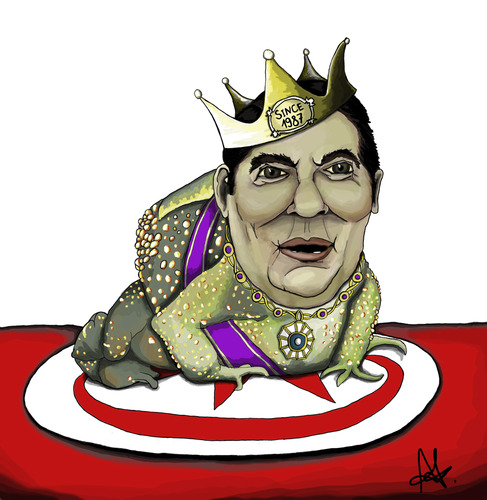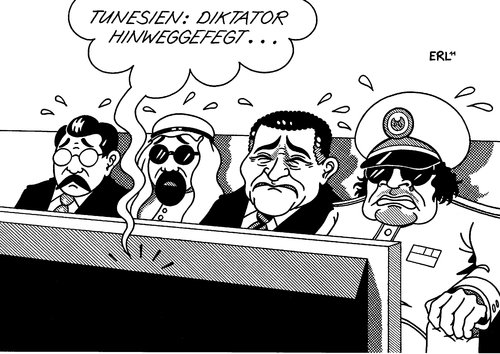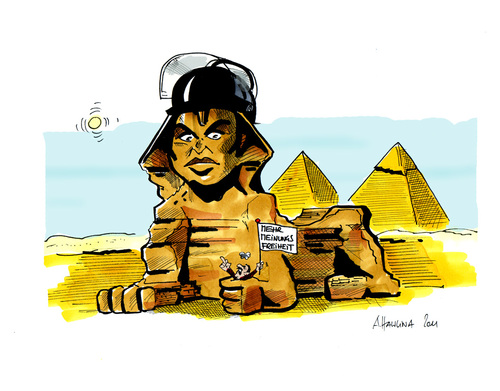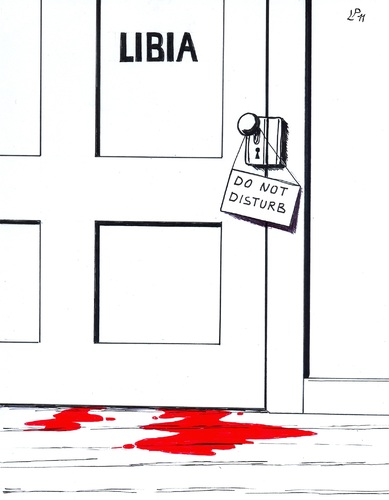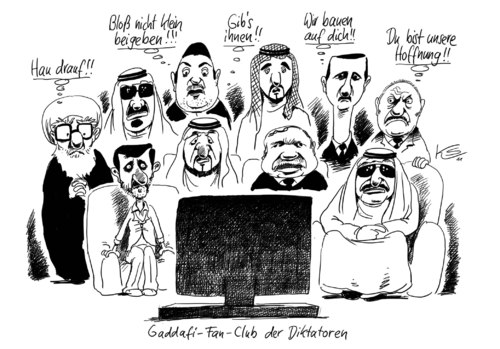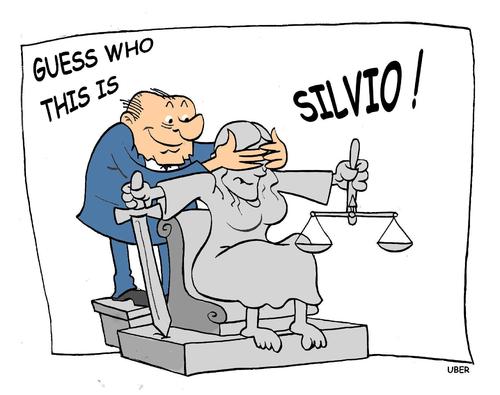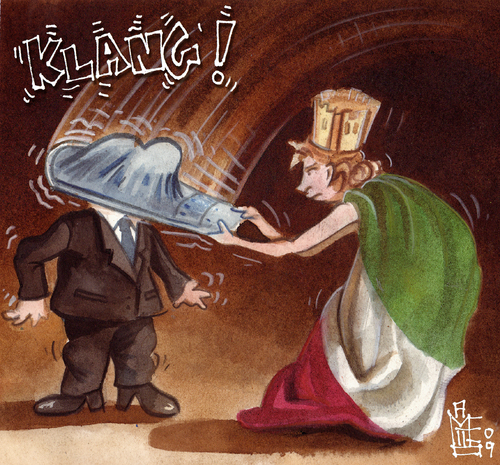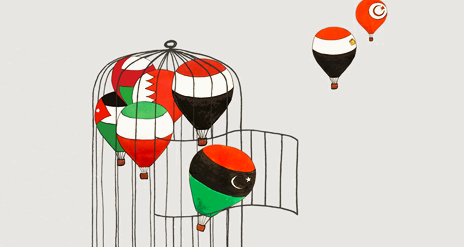
Nobody can predict what will come out of early 2011′s uprisings in North Africa and the Middle East and I am not going to try. What I can do, however, is to try to show how the treatment of the movements developed here on toonpool.com.
Pre-2011
While there are a few artists on toonpool.com who hail from countries like Egypt, Syria, Jordan, or Morocco, cartoons on this region’s domestic issues have been relatively few.
There is a single caricature of Tunisia’s Zine El Abidine Ben Ali and a handful of Hosni Mubaraks. A considerable amount of older cartoons tagged “Egypt” are basically mummy jokes. There is a bit more on Libya and Muammar Gaddafi, probably because he is the most flamboyant of the three and because of his four-decade history of insane supervillainity. Still, despite media stunts such as his 2009 call for dissolving Switzerland, there is not much to be found.
Today
Things have changed a lot since. For example, search results for “Egypt” have gone up by 125 per cent in the last three months while “Tunesien” went up by 440 per cent – if admittedly from a much lower number. This development started when protests in Tunisia made it into Western media.
I created the little infographic below to make it easier to follow the sequence of events. The dates are mostly taken from Wikipedia pages so don’t use them for any thesis you might be writing. I decided to stick with the events in Tunisia, Egypt, and Libya since it would have been too crowded had I included events in Bahrain, Yemen, Jordan, etc. Also, there are hardly any cartoons on events there.
Tunisia
The first cartoon that dealt with the situation in Tunisia was the “Ben Ali Frog Prince” by German artist Anitschka. It was posted on January 2, about two weeks into the protests. It remained the only one for more than a week. In fact, only three or four pieces werde added before Ben-Ali stepped down on January 14. The last of the three was, in fact, added on January 14, but before the President had fled the country.
Unsurprisingly, the number of cartoons on the situation in Tunisia rose considerably in the following days. Most of these cartoons can roughly be sorted into three categories: “making fun of Ben Ali” (e.g. this one), “poetic celebratory” (e.g. this one), and “who will be next?”. To me, the latter is the most interesting type since it showed up as early as January 16 and – with some variations – is still in use as of today.
The set of endangered leaders varies depending on the artist. Gaddafi and Mubarak are usually there – they were even before revolutions in their countries got serious. Among the others are Mahmud Ahmadinejad, Saudi Arabia’s King Abdullah, Syria’s Bashar al-Assad, Abdelaziz Bouteflika from Algeria, and, somewhat unexpectedly, Zimbabwe’s Robert Mugabe. (sample cartoons: 1,2,3,4,5).
Cartoons that deal with Tunisia and do not refer to it as part of a larger Arabian revolution disappeared by early February, even though the demonstrations continued. Cartoons are after all part of the international news cycle and public attention had moved east by then.
Egypt
Cartoons dealing with the demonstrations in Egypt first showed up in the afternoon of January 26 – I think this was the first one. Like most Egypt cartoons that would follow, these early ones made extensive use of pyramids, sphinxes, and mummies.
The ‘Egypt’ cartoons emphasize the role played by the internet, Facebook, Twitter and the like to a greater extent than the ‘Tunisia’ ones. Mr. Mubarak’s brilliant move to shut down the internet on January 28 certainly contributed to this (examples here, here, here & here).
Cartoons from the following two weeks tend to show Mr. Mubarak clinging to power (1,2,3) or his time running running out (1,2,3). Comments on Europe’s and America’s role in the conflict also show up more often than with Tunisia (e.g. here, here & here). Mubarak finally left on February 11 and the number of Egypt cartoons dwindeled down a few days later.
Libya
Toonpool.com members began to shift their attention to Libya around February 17 when reports about armed forces shooting at demonstrators hit the news. The first few posts were caricatures of Colonel Gaddafi that – I would guess – the artists still had in stock (1,2,3). The first proper cartoon (left) arrived very early on Februar 20.
In the following weeks the majority of “Libya cartoons” either made fun of Gaddafi as they had done with Mubarak (1,2,3) or illustrated violent actions of the regime (1,2,3). As the violence continued, the hopeful cartoons got fewer and fewer. On February 6 one member posted a telling variation of the “who will-be-next cartoon” mentioned above:
The other Arabian leaders threatened by uprisings are now cheering for Colonel Gaddafi’s troops hoping that the wave of revolutions wave will break in Libya.
It’s impossible to tell what will happen next. Will NATO establish a “no fly zone”? And, if they do, what will be the results? In any case, there will be cartoons that comment on the outcome.
PS: Finding a comprehensive list of cartoons on the Arabian revolutions is a bit tricky. For this article I used both our toonpool.com collections and the “Pro Search”. The best I can offer you is a general collection, one on Tunisia and one on Egypt. These may not include all cartoons on the matter, very often because of differing tagging conventions. They also tend to include cartoons that are onely remotely related. After all there are downsides to having an archive of more than 10,00 cartoons by over 2000 artists.
images: “Arab Revolution” by No, “Arabian Spring” by Samir Alramahi
]]>
Editorial cartoons are a part of political discourse. Some express liberal opinions, some are more conservative. Some cartoons criticize very specific shortcomings, some have a broader approach, some are clever, some border on propaganda. And so on. This is true for all democratic countries. In this interview – actually the first part of another “special” – I tried to find out more about how cartoonists see their own role in the political discussion.
In the United States the division between the liberal and conservative “camps” has become particularly visible in the last few years. This is at least partly an effect of the sales strategies of media outlets like Fox News or its liberal counterpart MSNBC. While toonpool.com has “left-leaning” members from a number of countries, the most vocal “conservatives” are/were Americans (RIP Joel Barbee). Since I wanted to talk to a liberal and a conservative from the same country, both my interviewees are based in the USA. National particularities like “paleoconservativism” left aside (read the interview to learn about this concept), I don’t think that they are much different from cartoonists from other countries.
Rex May, aka Baloo, is from Fort Collins, Colorado. He is a very productive cartoonist and has been working in the business since 1973. He is a vocal conservative, too.
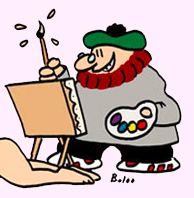 Rex, you do both political cartoons and “gag” cartoons. And, judging from input on toonpool.com, a lot of both. How many cartoons do you draw per day?
Rex, you do both political cartoons and “gag” cartoons. And, judging from input on toonpool.com, a lot of both. How many cartoons do you draw per day?
I draw at least twenty-five per week, usually more.
Do you prefer the political ones to the “gag” type?
Yes, a little, but of course they’re harder to sell.
What is it that makes political cartoons more interesting?
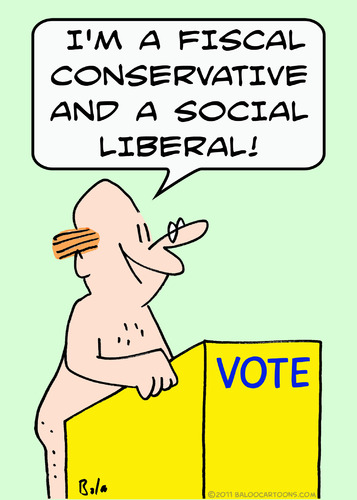 I suppose it’s because they’re more immediate. It’s much the same thing for me as reading political blogs and columns. It’s just another way to disseminate political and social facts and opinions.
I suppose it’s because they’re more immediate. It’s much the same thing for me as reading political blogs and columns. It’s just another way to disseminate political and social facts and opinions.
What function would you say do your political cartoons fulfill?
I try to express the paleoconservative point of view in cartoon form, which is rather rare these days in cartoons and everywhere else.
Can you tell me a bit more about your paleoconservativism? Would you say that it is something different from the current Tea Party discourse?
Sure. The Tea Party groups are really diverse in their thinking. They include neocons, paleocons, libertarians, and other types as well. Paleoconservatism is what conservatism was before the neocon takeover of the Republican party.
Paleocons believe in minimal government and are reluctant to intervene abroad. They want no social engineering from the government and want actual adherence to the Constitution. They are opposed to gun control and prefer government action to take place at the local and state level whenever possible. Most are immigration restrictionists.
The neocons use a lot of conservative rhetoric, but believe in a lot of intervention abroad, and big government and, basically, the whole liberal agenda.
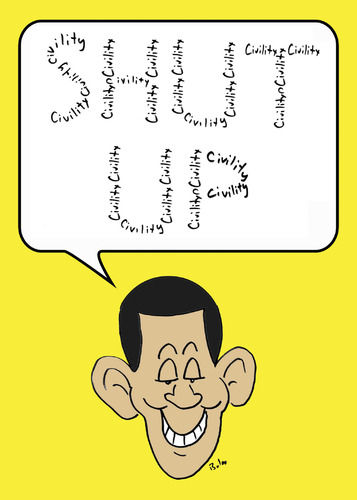 You’ve been working as a cartoonist since the 1970s. Is there, in your opinion, a current increase in partisanship in American media and the population?
You’ve been working as a cartoonist since the 1970s. Is there, in your opinion, a current increase in partisanship in American media and the population?
The prevalent ideology has changed by moving steadily to the left. What passes for ‘conservative’ positions today would have been considered liberal fifty years ago.
There is a bit of a paleocon revolt, because of the Tea Party movement, and there is now much more of a push for closing borders and adhering to the Constitution. Whether it keeps going or not is the question. The leading Republicans and Democrats differ hardly at all, and their ‘disagreements’ are mostly just rhetorical.
Do you think that political cartoons play a part in this?
I don’t think they influence people much, but they do reflect what people are thinking to some extent, so editorial cartoons are more of a result than a cause of political changes.
Do you follow other conservative political cartoons? And .. more interesting to me .. do you follow any liberal cartoons?
Sure, kind of randomly. I look at political cartoons regularly at Daryl Cagle’s website and of course most of them are liberal.
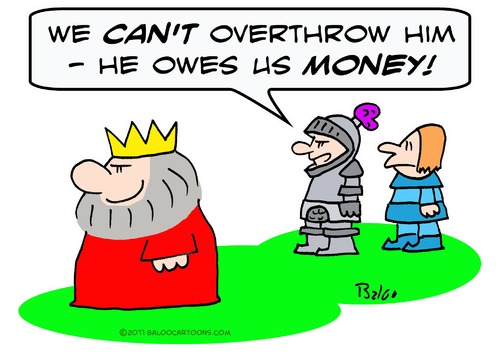 Do you think that some of the liberal political cartoons are funny? Is there some common ground?
Do you think that some of the liberal political cartoons are funny? Is there some common ground?
Sure. Many are funny even when I disagree with them. And of course I frequently agree with their opinions — especially the ones critical of foreign intervention — though liberals are often right for the wrong reasons, in my opinion.
Do you know any liberal cartoonists personally?
I’ve met very few other cartoonists in person because they tend to clump on the coasts and here I am in the Rocky Mountains, but I know a lot of them on the net, and have worked with lots of them — I’m also a gag writer, and I collaborate with cartoonists of just about every political persuasion. Cartoonists tend to be more liberal than other people, probably because artsy people in general tend to be.
Thanks for your time!
The second part of this special will be an interview with Bob Simpson who, together with Estelle Carol, creates cartoons for the American labor movement.
]]>In case you are interested in looking at all cartoons on the Swiss decision, there is a collection set up by user Hayati.
Introducing…
 New toonpool.com member Ilkay Saltık’s portfolio is strangely divided. There are some drawings that clearly lack artistic experience and are hardly more than mediocre doodles. Others – I would guess that these are his more recent works – are imaginative and promising illustrations. Take, for example, the capitalist with a hidden heart, the steam powered smiler or car crash crotch. I am sure that there will be more of the good stuff in the days to come.
New toonpool.com member Ilkay Saltık’s portfolio is strangely divided. There are some drawings that clearly lack artistic experience and are hardly more than mediocre doodles. Others – I would guess that these are his more recent works – are imaginative and promising illustrations. Take, for example, the capitalist with a hidden heart, the steam powered smiler or car crash crotch. I am sure that there will be more of the good stuff in the days to come.
Cartoons of Interest
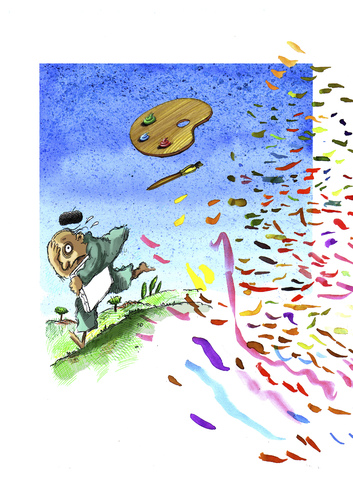 My favorite cartoon this week is “Der Landschaftsmaler” ["The Landscape Painter"] by Mehmet Karaman, who, incidentally, is from Switzerland. Is that painter being attacked by his own colors or by wild ones? Or have both of them joined forces against his naturalism? Anyway, this is a great cartoon. And it is mysterious in a good way.
My favorite cartoon this week is “Der Landschaftsmaler” ["The Landscape Painter"] by Mehmet Karaman, who, incidentally, is from Switzerland. Is that painter being attacked by his own colors or by wild ones? Or have both of them joined forces against his naturalism? Anyway, this is a great cartoon. And it is mysterious in a good way.
Paul Hellmich
]]>
![]() Farhad, two of your major topics are freedom and censorship… Do you have any personal motivation for concentrating on those two?
Farhad, two of your major topics are freedom and censorship… Do you have any personal motivation for concentrating on those two?
Censorship is an scary shadow which has followed me all my life…and I hate it. Therefore I talk about it. Freedom is a topic that concerns many people on this planet. I have never had as much freedom as I wished. Being born in Iran is just like being born in a cage. After that you will always be looking for freedom.
How did censorship follow you? Did you experience censorship in Europe as well?
Censorship loves artists and intellectuals! It never lets us go. I experienced this almost everywhere, under different names and in different shapes. But I can recognize it everywhere: even in Italy and Holland – anywhere.
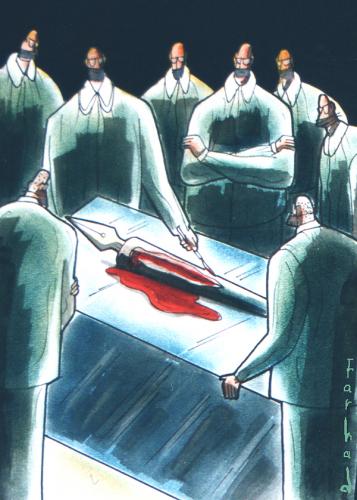 Would you mind telling me in which way your work has been censored in Iran and in Europe?
Would you mind telling me in which way your work has been censored in Iran and in Europe?
If I make something that questions their politics or authorities they will find a way to let me know that they are not happy with that. I can lose my job because of that. This has happened many times in my life. They make me understand that, if I want to work and have a better life, I have to be careful about what I say.
On your website you state that you have been born three times, what do you mean by that?
I was naturally born in Teheran. Later I had to emigrate twice – once to Holland and once to Italy. Each time changing place, country and direction of my life was like being born again. I said that I have been born three times because each time I had to start everything over again, just like a baby.
You returned to Holland in 2000 after some time in Italy. How did it feel to come back to a place you had left?
It did feel like a kind of coming back home. It may sound strange, but I miss all the places that I have lived in. Even those that felt like a cage!
Could you imagine moving back to Iran? What was the reason you had to leave your birthplace – how was it like a cage for you?
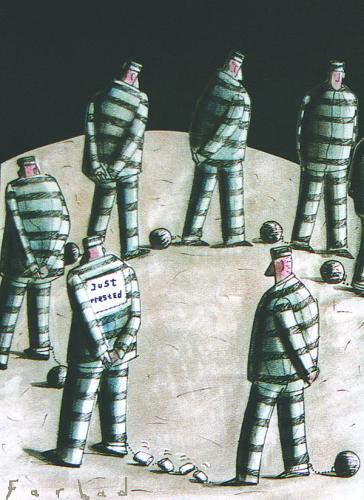 Cage is maybe not the best word to describe the situation in Iran. As a bird in a cage, someone will take care of you. They will give you water and food and maybe even love. At the time that I left, Iran was more like hell than like a cage – there was the war with Iraq, daily bombardments, not having my freedom, etc. I had to go away and I did it.
Cage is maybe not the best word to describe the situation in Iran. As a bird in a cage, someone will take care of you. They will give you water and food and maybe even love. At the time that I left, Iran was more like hell than like a cage – there was the war with Iraq, daily bombardments, not having my freedom, etc. I had to go away and I did it.
I would love to go back to Iran, but after 24 years in Europe it wouldn’t be easy for me to leave my work, my friends and everything behind me. I created a life, a world for me here and I cannot leave it behind.
Do you still have any connections to Iran today?
Almost every day – with my colleagues, family, …
Would you say that Iran has changed since you left it?
Very much: cities, roads, people, culture, many things.
Would you say that there is a place that is “home” to you? How would you define it?
To me, “home” is a place where I feel that I’m not alone. A place where you can feel that you exist, where you are being seen. Sometimes I have that feeling in Iran, sometimes in Holland, even in Berlin. It is a strange feeling, but “home” to me is a wish, a dream, a utopia. Or maybe “home” is just something inside ourselves.
Thanks for your time!
Paul Hellmich
]]>
The Middle East Conflict is one of the most frequent topics for cartoons on toonpool.com – and one of the most controversially discussed. I dare say that no other issue has created as much uproar: there have been deletions of cartoons, allegations of anti-Semitism, complaints about censorship and loads of angry comments. One thing I have been missing, however, was actual dialogue.
![]() Ramzy A. Taweel was born in Beirut in 1978 to a Palestinian father and a Lebanese mother. In 1993, shortly after the Oslo Agreement, his family returned to Palestine. Today, Ramzy lives in Ramallah and works as a media officer for the Palestinian president’s office. He is also about to complete his MA thesis in International Studies and he is drawing pretty cool cartoons about everyday life in Palestine. I asked him a couple of questions about life in Ramallah and about relations between “us” and “them”. Which can be read as Israelis and Palestinians, as Jews and Muslims, as men and women or as TV-addicts and fundamentalists, depending on what part of the interview you are reading.
Ramzy A. Taweel was born in Beirut in 1978 to a Palestinian father and a Lebanese mother. In 1993, shortly after the Oslo Agreement, his family returned to Palestine. Today, Ramzy lives in Ramallah and works as a media officer for the Palestinian president’s office. He is also about to complete his MA thesis in International Studies and he is drawing pretty cool cartoons about everyday life in Palestine. I asked him a couple of questions about life in Ramallah and about relations between “us” and “them”. Which can be read as Israelis and Palestinians, as Jews and Muslims, as men and women or as TV-addicts and fundamentalists, depending on what part of the interview you are reading.
Ramzy, can you tell me how you ended up drawing cartoons?
My passion for cartooning officially started in 2002, when I was trying to amuse a beautiful lady at my university. That was when I created my cartoon character Fashcool, a Palestinian college boy who is trying to live a normal life under occupation. The lady is long gone, but Fashcool stayed with me. Moreover, it made me a celebrity at my university and finally at universities all over Palestine.
What limitations do you face in everyday life in Ramallah due to the political situation?
Limitations? … First, I did not travel out of Ramallah from more than five years – since 2001. And Ramallah is a pretty small town. There are too many things happening for the size of this place. I’ve seen death and joy, soldiers and tanks. I’ve seen airplanes bombing houses, soldiers humiliating people and kids crying. I’ve walked through a blizzard together with two thousand other students because the Israeli army had closed the road between my university and Ramallah.
In your cartoons on Palestine, you hardly ever make explicit reference to Israel. Why is that so?
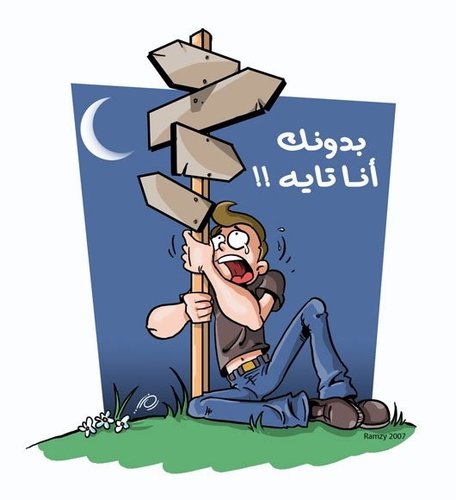 In my cartoons, I try to show my own perspective, not the political situation as a whole. I draw cartoons about every day situations – about love and friendship and about how the occupation affects our lives.
In my cartoons, I try to show my own perspective, not the political situation as a whole. I draw cartoons about every day situations – about love and friendship and about how the occupation affects our lives.
For example, since I am from Ramallah, I couldn’t marry a Palestinian girl from Jerusalem. The whole relation was very stressful and even dangerous for her: Israel might have taken away her ID papers and kicked her out of Jerusalem just because she slept outside the city limits. I drew a lot of cartoons about this situation and about how I lost my love because of it. I also draw about how I am not able to meet my friends because of the wall. All of these are very personal issues. I can’t see them as an abstract political crisis; it’s simply personal pain.
When I draw cartoons, I look for that tiny light that might draw a smile despite the bloody scenery. Young people here have to face multiple problems: their studies, love, work, family and the occupation. Forcing them to smile even at the darkest times is how I fight the occupation.
Is it possible to sum up the position of the Palestinian people toward Israel or are there differences between certain groups?
People are people on either sides. But the problem is not so much between Israelis and Palestinians and it’s definitely not a war of religions. Two plain words: the occupation and the settlements. That’s where the trouble lies. Shortly after the Oslo agreement, Israelis were visiting Ramallah and the other Palestinian cities almost on a daily basis. 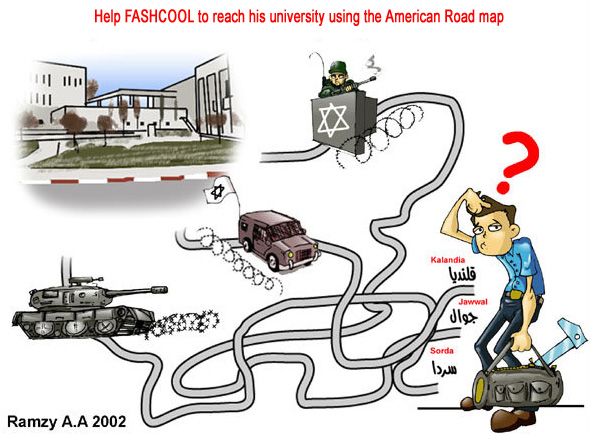 Even today, the economic relations between the West Bank and Israel are more important than the European market. But the settlements eat up Palestinian land and cut off the roads between our cities. Israel even controls over 80 percent of our water supply. They sell our own water back to us.
Even today, the economic relations between the West Bank and Israel are more important than the European market. But the settlements eat up Palestinian land and cut off the roads between our cities. Israel even controls over 80 percent of our water supply. They sell our own water back to us.
But when the Israeli government finally accepts the fact that we must and will have our sacred right of freedom and independence, when they demolish the apartheid wall, you will see how fast wounds can heal.
You say that the West Bank Wall is one important obstacle on the way to peace. What is your reaction to the Israeli argument that the barrier has effectively prevented suicide attacks and thus saved hundreds of lives?
Actually, my problem is not with the wall itself. It’s rather that it was built on our side of the border. On lands inside the 1949 green line which is recognized by the UN as the border of the Palestinian territories.
The wall cuts West Bank into blocks and ghettos with electronic gates between them. For instance, the city of Qalqilyah is completely surrounded by a 9 to12 meter wall. There is a single gate that opens and closes depending on the mood of the Israeli soldiers guarding it.
The wall is a tool to seize more ground from us and to protect settlements. It’s a tool to maintain the occupation, not to protect Israel.
In the past, there have been several cartoons uploaded to toonpool.com that comment on the Palestinian conflict in an aggressive way that is sometimes pretty close to being anti-Semitic…
Paul, if you lived in Palestine for less than one month you might begin to think the same. Yesterday my brother was escorting our dad in an ambulance from Jordan. My dad is dying … and they did not let my brother stay with him. There was no one to hold his hand. Not to mention they forced the doctors to switch ambulances at the border.
I do my best to separate between religion and politics. I almost never use the Star of David. Instead, I use “צה”ל” (“Tzahal”), the acronym for Israel’s military forces. It’s not the Jews but the state of Israel that has committed war crimes against myself and against my people.
As for other cartoonist… You see, I can’t blame them because Israel made it very hard for cartoonists to separate religion from politics.
This question might be a bit naïve: I noticed that most of your characters have a very “western” look. The only reference to a Muslim society I’ve found was that woman wearing a long dress in the background of your “beach” cartoon. What are your reasons for doing it that way?
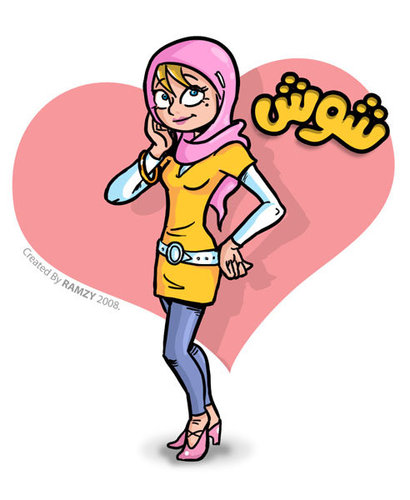 Actually, this is what we are. Palestine is neither Afghanistan nor Saudi Arabia. We are more moderate than you might imagine. Islamic costumes and ways of living only came up in the past 15 years. They are a part of the growth of fundamentalist Islam which has several reasons. There is the failure of development in several Arab countries, for example. And there are some oil states in the Gulf region that actively support extremist views like Wahhabism.
Actually, this is what we are. Palestine is neither Afghanistan nor Saudi Arabia. We are more moderate than you might imagine. Islamic costumes and ways of living only came up in the past 15 years. They are a part of the growth of fundamentalist Islam which has several reasons. There is the failure of development in several Arab countries, for example. And there are some oil states in the Gulf region that actively support extremist views like Wahhabism.
In fact, I’ve drawn several cartoons with females wearing so-called Islamic dresses. But, again, you would be surprised to see what kind of dresses we have here. Women are women anywhere in the world. They will search for beautiful clothes no matter where they live.
As for me, I am a practicing Muslim., but I do live in a global era. You and me, we share values and a way of life. I watched every episode of Saved by the Bell even when I lived in a camp in Jordan. Michael Jackson is my favorite singer and Steve Irwin was my hero. I cried when I heard that he was dead. This is not a Western era anymore, it’s a Global culture with a Western look, don’t you think?
Thanks for your time!
Paul Hellmich
]]>The Berlusconi cartoons are pretty uniform in their evaluation of the court’s decision – no one seems to like that little rich guy. As you would suspect, a lot of them come from Italy. Some, unfortunately, exceed my language skills and the Google translator (my Italian is basically French with an accent). So, if anyone could translate one of these, I’d be happy. Cartoons without words or even in English are easier. I liked the way these two by Uber and Matteo Bertelli correspond if you ignore that it’s Lady Justice in one cartoon and Italia Turrita in the other.
As a whole, the cartoons express some hope that Signore B. will finally feel the consequences of his actions (take either one of these). And then there is this one that shows Lady Justice dropping her blindfold and as a consequence all that makes justice just. I don’t know if this was intended or not.
The Obama cartoons differ in their interpretation of the event but, as a friend pointed out to me, a lot of them replicate toonpool.com’s well-established categories of opinion. There are those that emphasize the hope for change (this one and this one). There are those that concentrate on aggressive American foreign policy (here and here). There are those that… dislike Obama (here). And there is George W. Bush winning the prize.
Finally, there are two cartoons that manage to include Silvio and Barack (here & here).
Cartoons of Interest
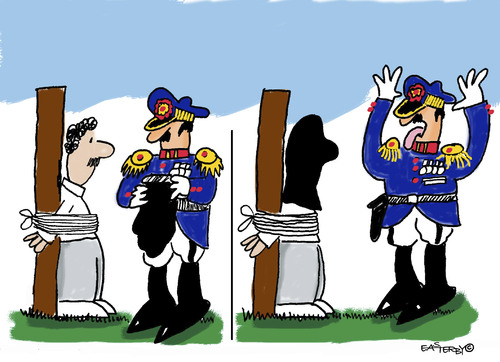 My favorite this week is “Execution” by Easterby. It’s a very classic cartoon – banana republic-style military executions definitely are cliché cartoon settings. And a similar joke has been made in several films and TV programs (with a blind guy instead of an executionee). But I still laughed. Take that, innovative humor.
My favorite this week is “Execution” by Easterby. It’s a very classic cartoon – banana republic-style military executions definitely are cliché cartoon settings. And a similar joke has been made in several films and TV programs (with a blind guy instead of an executionee). But I still laughed. Take that, innovative humor.
Paul Hellmich
]]>
Max, can you tell me about the cartoons you have removed from toonpool.com so far?
Well, basically we will delete all images that violate our terms of use. This includes, for example, copyright infringements. We have removed a couple of pictures that were using copyrighted characters, e.g. Donald Duck or Warner Brothers characters, without adding some new interpretation.
Another reason for removing cartoons is plagiarism – sometimes artists have obviously stolen somebody else’s ideas. Of course it’s often difficult to determine whether a cartoon has been plagiarized or if people just got the same ideas. Somebody even put up a collection dealing with that matter. A third category would be offensive and discriminating content directed against any group or individual.
Most of the deleted images that raised complaints about censorship were political in nature. Were there any similarities between the ones you removed?
We have been running toonpool.com for almost two years now and there are members from 140 countries representing all major religions. So, when it comes to political cartoons, there are necessarily differing points of view the users will express in their art.
The most outstanding event in this matter were the Israeli attacks on Gaza in January 2009. A lot of the cartoons we received were directed against Israel’s policy. Some of them, however crossed a line. There were some openly anti-Semitic cartoons and others that compared Israel to Nazi Germany, often using swastikas. Those clearly violated our terms of use and have been deleted.
Some users have called this censorship, keeping them from expressing their opinions.
As administrators, we have to set some rules of conduct. There are mainly three reasons for doing so: First of all, toonpool.com is supposed to be a site for an exchange between artists from different cultures. Such exchange is endangered by hateful statements, so we try to keep things peaceful while trying to allow for a maximum range of opinions.
Second, there is a legal dimension. Toonpool.com is hosted in Germany, where as a consequence of our history the use of swastikas and similar symbols is limited by the law and incitement to ethnic or racial hatred is a criminal offense.
Third, the toonpool.com staff feels a responsibility to take a position in these kind of things. As I said, we allow for a maximum range of artistic expression. We try to remain as neutral as possible and keep a lot of cartoons and images that we disagree with. Sometimes we need to act, though. We don’t want our site to be misused for aggressive propaganda.
But people might argue that other comparisons with Hitler or the Nazis are still online, take this caricature of Mahmoud Ahmadinejad, for example.
Basically, we disagree with any comparisons between Nazi Germany and other states. They necessarily distort the system depicted and tend to trivialize the horrors of National Socialism. Still, we kept some of them owing to toonpool.com’s ideal of artistic freedom. Drawing parallels between Israel and the Nazis in our eyes is especially harmful and hateful and will not be tolerated. It doesn’t do anything to explain the Israeli / Palestinian conflict and is a severe insult to the experience of the Jewish people during the 1930s and 1940s.
We are currently rethinking our policy towards Nazi imagery in general, but haven’t come to a decision yet. Concerning the latest incident, I hope that the users will accept our position and respect our terms of use.
I noticed, that you have two ways of dealing with controversial pictures: sometimes you just delete them but in the most recent case you replaced it with a disclaimer and left the comments. What effect do you hope this will have?
Replacing the image was my idea, this was the first time we tried it. Partly, we did it for technical reasons: If somebody posts a link to a picture that has been deleted, its better to have the disclaimer in place of the picture than an error message. On the other hand, we wanted to offer the opportunity to further discuss the topic.
Will you do this with all removed pictures in the future?
We will do this in most cases of cartoons that don’t fall into the copyright violations category. If an artist keeps uploading a picture we deleted, however, we will remove his profile from our site. The new procedure is meant to provide more transparency. I hope that the opportunity to discuss these matters will relieve some tensions.
Thank you for your time!
Paul Hellmich
Image: “Censorship” byAlexei Talimonov
]]>Source: http://www.toonpool.com/cartoons/Iran_53474
The recent presidential election in Iran and its aftermath found huge international coverage and attention.
As you may know, there was a huge and unprecedented turn-out in balloting, which was a sign of the Iranian people’s will to reform the current situation of the country. But the aftermath of the election was so desperately annoying that no free soul can ever close his eyes on it.
The same is true for the cartoonists. They have always accompanied people in portraying pains and in offering criticisms, in denouncing violence and in promotion of justice; and they have always called for peace. The same is true for the time being. The cartoonists feel an obligation to stand by people who have faced such unkindness.
We the cartoonists have always tried to laugh people out of pain and pressure. But how can one witness killing of brothers and sisters and still remain silent?
In such a situation, the 9th Tehran cartoon Biennale is on the way. Due to the post-election events, the cultural joy has totally disappeared from Iranian society. So we don not see any real interest in holding such a Biennale. In the current situation, we see our responsibility in a different perspective which does not necessarily include laughing and making laugh.
Due to this fact, we the undersigned cartoonists, declare that we would not participate in this international festival. Previously, the festival has been held by cooperation and sympathy of professional Iranian cartoonists but this time, we would not cooperate or participate.
1- Arvin
2- Nahideh Asiabi
3- Mahdi Aghajani
4- Mojtaba Adibi
5- Majid Adibi
6- Ali Asadi
7- Leyla Afsari
8- Reza Amirriahi
9- Sepideh Anjomrooz
10- Roya Anooshe
11- Mehran Iranlou
12- Mohsen Izadi
13- Sadegh Bagheri
14- Hamed Bazrafkan
15- Rahim Baghal Asghari
16- Saied Behdad
17- Hamid Bahrami
18- Vajihe Pari Zangane
19- Payam Pourfallah
20- Naeem Tadayon
21- Yahya Tadayon
22- Abdolebad Taghavi
23- Mahdi Tamizi
24- Abdolhadi Sanaie
25- Saied Janghorban
26- Shahb Jafarnejad
27- Javad Jafarian
28- Mahmoud Javadi
29- Bozorgmehr Hosseinpour
30- Hadi Heidari
31- Sasan Khadem
32- Nazanin Khami
33- Mohammad Khodadadi
34- Hossein Khosrojerdi
35- Morteza Khosravi
36- Hamid Kholghi
37- Behnam Khamisi
38- Mohammad Ali Khoshkam
39- Hamideh Khiabani
40- Hesam Dadkhah
41- Rahman Dadgostar
42- Behtash Davarpanah
43- Saied Davari
44- Hamidreza Davoudi
45- Ali Derakhshi
46- Paria Dehghani
47- Khashayar Radafshar
48- Farshid Rajabali
49- Jamal Rahmati
50- Maryam Rahimi
51- Hadi Rahimi
52- Saied Razzaghi
53- Ardeshir Rostami
54- Dariush Rmezani
55- Kianoosh Ramezani
56- Shiva Zamanfar
57- Kiyarash Zandi
58- Keyvan Zargari
59- Afshin Sabouki
60- Pouya Seyedkazemi
61- Fateme Shakool
62- Hooman Shahbandi
63- Mahdi Sadeghi
64- Hamid Sadeghian
65- Hossein Safi
66- Majid Salehi
67- Mohsen Zarifian
68- Ahmad Abdollahinia
69- Ahmad Arabani
70- Mahdi Alibeigi
71- Faez Alidoosti
72- Javad Alizadeh
73- Amin Alinia
74- Nooshin Omrahi
75- Arash Farrokhi
76- Hesam Fetrati
77- Mohammad Feizabadi
78- Asad Binakhahi
79- Majid Kazemi
80- Mahdi Karimzadeh
81- Ehsan Ganji
82- Ghasem Lotfi
83- Firoozeh Mozaffari
84- Bahar Movahhed Bashiri
85- Amin Moayedi
86- Shahnaz Mohi
87- Ali Miraee
88- Ayat Naderi
89- Mahnam Najafi
90- Alireza Nosrati
91- Maryam Noormohammadzadeh
92- Saeid Noroozi
93- Mana Neyestani
94- Vahid Nikgoo
95- Pantea Vaeznia
96- Hooman Hadizadeh
97- Ali Honarvar
98- Mohammad Sadjad Taheri
99- Mahmood Mohammad Tabrizi
100- Saeid Nemati
101- Salman Raeis Abdollahi
102- Peyman Rezaee
103- Bijan Asadipour
104- Hossein Shishegar
105- Saeid Ahrabi
106- Ali Mohammadi
107- Mohammad Tahani
108- Hamidreza Pournasiri
109- Masoud Mahini
110- Ali Tajaddod
111- Mahdi Mohammadi Roozbahani
112- Rafat Hashemi Sisakht
113- Saleh Tasbihi
114- Nima Jamali
115- Jalal Rahmati
116- Ali Jahanshahii
117- Alireza Hesami
118- Mohammah Saleh Razm Hosseini
119- Soroush Dastmalchina
120- Arezoo Aghababaeian
121- Hanif Bahari
122- Monire Kordestanchi
123- Armin Golchoobian
124- Mahnaz Yazdani
125- Mohammadreza Mobayen
126- Mahmood Salami
127- Behzad Riazi
128- Edik Boghosian
129- Maryam Farahzadi
130- Salman Taheri
131- Ghasem Elahi
132- Taravat Niki
133- Javad Karimifar
134- Syavash Zarrinabadi
135- Amir Dehghan
136- Sadegh Karaei
137- Ali Akbar Aryanfar
138- Morteza Azarkheil
139- Alireza Moghaddam far
140- Ehsan Mousavi
141- Atefe Madani
142- Mohsen Jafari
143- Farid Mortazavi
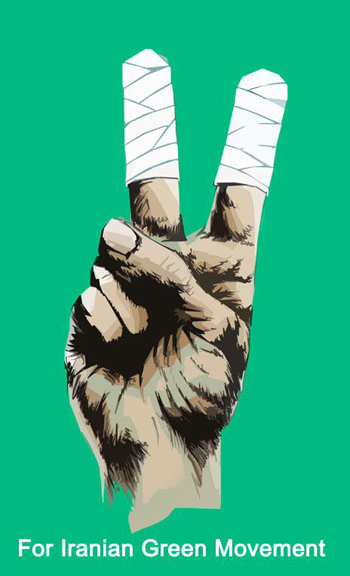 By Ali Miraee (Tehran, Iran)
By Ali Miraee (Tehran, Iran)
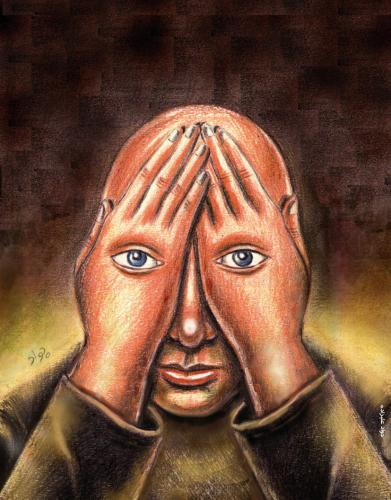
“Hidden Eye” by Javad Alizadeh (Tehran/Iran)

